Injury by Firearms Australia 1994
Injury by Firearms Australia 1994
J Harrison, J Moller, S Bordeaux
June 1996
- 522 deaths caused by firearms were registered in Australia in 1994.
- In addition to deaths, about 500 hospital admissions each year are due to
non fatal firearm related injuries.
- Firearm deaths comprise 7.3% of all injury deaths.
- Most firearm deaths are suicides; most admitted cases are due to accidents.
- Firearm death rates have declined in recent years.
- Firearm death rates are generally higher in rural and remote areas than in
urban areas.
- Australia has a higher firearm related homicide rate than England &
Wales and Switzerland, but lower than Canada and much lower than the United
States.
|
Males |
Females |
Persons |
| Cases |
468 |
54 |
522 |
| Percent of all injury deaths |
9.2% |
2.6% |
7.3% |
| Crude rate/100,000 pop |
5.3 |
0.6 |
2.9 |
| Age adjusted rate/100,000 pop |
5.3 |
0.6 |
2.9 |
| Change in age adj. rate since 1993 |
-4% |
33% |
0% |
| Average years lost before age 75 yrs |
33 |
39 |
34 |
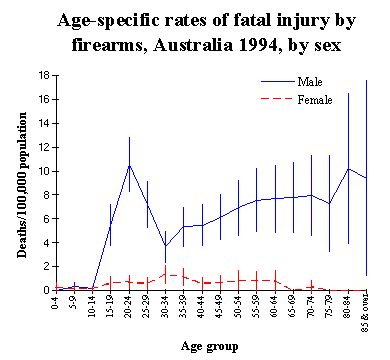
(Note vertical lines show 95% confidence intervals ) |
- More than 90 percent of people dying due to firearm injuries were males.
- For males, rates were highest for young adults and in old age.
- For females, there was less variation of rates with age. Rates were low in
old age.
|
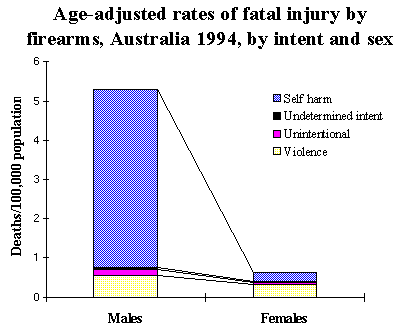 |
- Suicide accounted for 85% of male firearm deaths, homicide for 10%, and 3%
were registered as accidental. Intent was not stated for the remainder.
- For females, homicide accounted for 52% of firearm deaths, suicide for 36%
and 10% were registered as accidental. Intent was not stated for 2%.
|
The routine deaths data set holds no information about the assailant, in the cases
of firearm homicide. Other data (Australian Institute of Criminology) show that
most homicides are perpetrated by males, especially males aged 15 to 29 years.
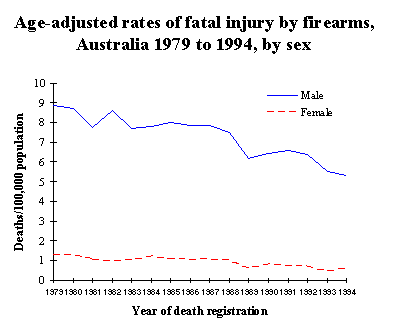 |
- Firearm death rates have declined in recent years, especially for males.
- Contributing most to the decline were a drop in the rate of firearm
suicide, and in the rate of firearm homicide.
|
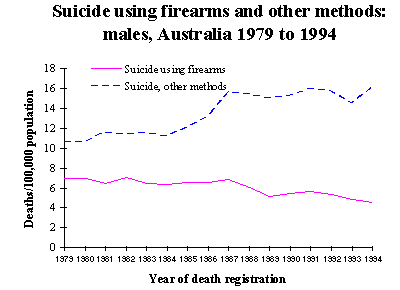 |
- The male rate of suicide using other methods has risen while the firearm
related suicide rate has fallen.
- For female suicide and for male and female homicide, death rates due to
firearms have dropped in relation to rates due to other
methods.
|
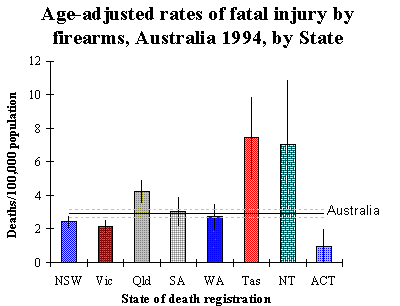
(Note vertical lines show 95% confidence intervals ) |
- The rate of registered deaths due to firearms was significantly higher than
the national average rate in Queensland, Tasmania and the Northern Territory.
- Rates recorded for Victoria and the ACT were significantly lower than the
national rate.
- A high firearm suicide rate for older males contributed to the high rate in
Tasmania.
- One-third of the firearm deaths registered in the Northern Territory were
recorded as homicides, higher than the national average (15%).
|
| Total Firearm death rate, males, by type of region: Annual Average 1990-1992 |
| Type of region |
Rate per 100,000 |
Relative risk compared with capital city |
| Capital City |
4.1 |
1.0 |
| Other major Urban |
7.2 |
1.8 |
| Rural Major |
9.0 |
2.2 |
| Rural Other |
13.3 |
3.2 |
| Remote major |
10.3 |
2.5 |
| Remote other |
21.0 |
5.1 |
Source: Australian Injury Prevention Bulletin 8 1994
- Firearm death rates are generally higher in rural and remote regions, with
the highest rate in low population density "rural other" and "remote other"
regions.
- The overall suicide rate was high in "rural other" and "remote other"
regions particularly among 15-24 and 45-54 year old males. While numbers of
firearm deaths in these regions are too small to definitively assess age
specific patterns, it appears that firearms make a significant contribution to
deaths in these high risk categories.
| International firearm and other homicide rates per 100,000 persons, 1994 |
|
Switzerland |
England & Wales |
Australia |
Canada |
USA |
| Firearm |
0.5 |
0.1 |
0.4 |
0.7 |
6.3 |
| Other |
0.7 |
1.2 |
1.5 |
1.6 |
2.7 |
| Total |
1.2 |
1.3 |
1.9 |
2.3 |
9.0 |
|
|
|
|
|
|
Source
Australian Institute of Criminology May 1996, and Killias 1993 (1994 data except Switzerland 1983-1986.)
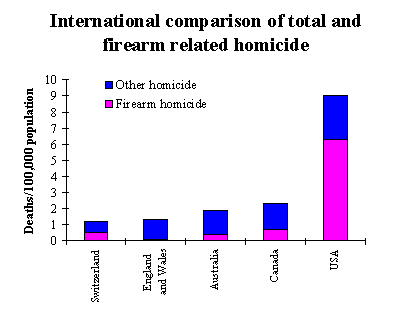 |
- The Australian firearm homicide rate is higher than England and Wales,
about equal to Switzerland, but much lower than Canada and the United States.
- The proportion of firearm homicide is minimal in England and Wales but
represents 70% of United States homicides.
- In Australia the proportion of firearm homicide is 21%, in Canada 26% and
Switzerland 40%
|
| Percentage of households owning a firearm |
| Switzerland |
England & Wales |
Australia |
Canada |
USA |
| 27.2 |
4.7 |
19.6 |
29.1 |
48.0 |
Source: Killias 1993
- Rates of homicide and suicide, and proportions due to firearms, vary widely
between countries.
- Availability of firearms also varies between countries based on estimates
of proportion of households with a firearm.
- Association has been found between firearm ownership, and both suicide and
homicide. This has been found when comparing levels for whole countries (eg
Killias 1993), though such studies have important limitations. It has also been
found when comparing individuals in households which did or did not have a
firearm (Brent et al 1992; Kellermann et al 1992, 1993).
| Firearm related hospital separations Australia (excl NT) 1992/93 |
|
|
|
Total Hospital Separations |
Died in hospital |
Total Hospital Bed days |
| 1992/93 |
|
|
|
| Unintentional |
368 |
7 |
2539 |
| Self harm |
104 |
18 |
1020 |
| Violence |
95 |
7 |
627 |
| Total |
567 |
32 |
4186 |
- Approximately two thirds of injuries related to firearms resulting in
hospitalisation are unintentional. This is in sharp contrast with deaths data.
Events recorded as self harm account for about 17% to 18% of cases and violence
for about 15% of cases.
- Less than 10% of hospitalised cases die in hospital, with the exception of
those as a result of self harm. This suggests that the majority of these cases
are in addition to those recorded in death statistics.
- 30% of injuries involved the head of the victim and treatment of all
hospitalised cases required 4186 bed days
| Hospitalised cases; body regions injured |
|
n |
% |
| Head, face |
170 |
30.0 |
| Lower limb |
145 |
25.6 |
| Upper limb |
117 |
20.6 |
| Neck, trunk |
47 |
8.3 |
| Other mainly superficial |
88 |
15.5 |
| Total |
567 |
100.0 |
- Deaths data are supplied by coroners and State registrars to the Australian
Bureau of Statistics. Data in this document are extracted from unit record
files. Tables are based on State and year of death registration.
- Hospital Separations data are supplied by State and Territory Health
Authorities to the Australian Institute of Health and Welfare. Data in this
paper are extracted from unit record files.
- Additional information was drawn from the following publications.
Australian Injury Prevention Bulletin 8: The Spatial distribution of injury
deaths in Australia, NISU, Adelaide, 1994.
Killias M. International correlations between gun ownership and rates of
homicide and suicide. Can Med Assoc J 1993;148:1721-1725
Australian Institute of Criminology Data on Firearms and Violent Death,
Canberra, May 1996
- Firearm related injuries are defined below:
| Description |
International Classification of diseases External causes codes |
| Unintentional |
E922 |
| Self Harm |
E955.0-.4 ,.9 |
| Violence |
E965.0-.4 |
| Intent Unknown |
E985.0-.4 |
Note:
Incidents classed as legal intervention E970 have been excluded (n=7,
Australia 1994).
- Most all-ages rates have been adjusted to overcome the effect of
differences in the proportion of people of different ages (and different injury
risks) in the populations that are compared. Direct standardisation was
employed, taking the Australian population 1991 as the standard.
- Confidence intervals (95%: based on a Poisson assumption about the number
of cases in a time period) have been placed around rates as a guide to the size
of the this variation. Chance variation alone would be expected to lead to a
rate outside the interval only once out of 20 occasions.
Brent DA, Perper JA, Allman CJ, et al. The presence and accessibility of
firearms in the home of adolescent suicides: a case-control study. JAMA.
1992;266:2989-2995.
Kellermann AL, Rivara FP, Somes G, et al. Suicide in the home in relation to
gun ownership. N Engl J Med. 1992;327:467-472.
Kellermann AL, Rivara FP, Rushforth NB, et al. Gun ownership as a risk factor
for homicide in the home. N Engl J Med. 1993;329:1084-1091.
|